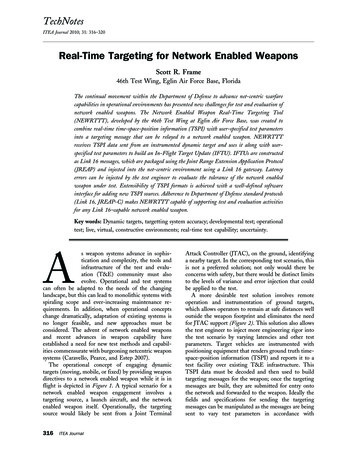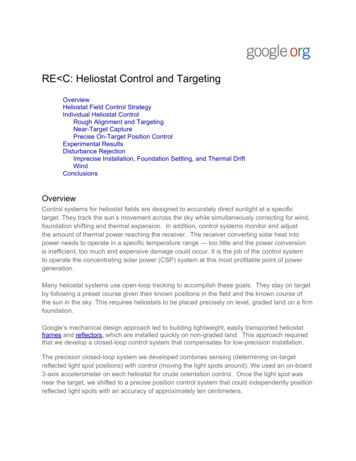
Transcription
International Journal of Humanities and Social ScienceVol. 4, No. 9(1); July 2014The Four Factors for Targeting an Attractive MarketKhaled AlmgrenPh.D candidateDepartment of Computer ScienceUniversity of BridgeportAbstractMarketing is a key concept in any business. There are many aspects of marketing such marketing techniques. Thispaper focuses on how to target a market. This paper has defined four factors for targeting an attractive market,i.e. size of market, growth, stability, and competition that affects the business or firm to target an attractivemarket is analyzed using rational analysis. It aims to identify the positive effects of such factors in determining thetarget market. The study finds that such factors positively affect the process of targeting an attractive market.Keywords: profit, market targeting, size of market, growth, stability, competitionIntroductionFirms or businesses exist when there is a market to serve or when there is a demand to fill. Expansion for anexisting firm is a complex process much less starting from scratch. When deciding to choose a market, there aremany considerations that have to be done on the manager's level and on the business level. Normally, a questionon profitability will be made first. No firm or business of any kind would ever consider profit as a driving factorfor making business. In the global economy's current situation, markets are now more integrated andinterconnected. That gives a level of interdependence among nations and its businesses more noticeable andundeniable. The recent credit crunch and economic downturns in Europe and America have put much of the worldin its toes. It is evident that such events are led by the increasingly open ways of doing businesses. Targetingmarkets now are as primal as ever. It is no longer an isolated and personal company objective like the earlierperiods of market surges (80s, 90s). Now, managers are more willing to make bigger decisions that will maketheir companies more profitable [1].Across the target market and segmentation literature, experiences have been varied. [2] Christopherson foundearlier that firms not only often target low-risk but profitable markets but also learn to "discriminate among clientsor customers". This is true since targeting a market segment that is in line with expectations, preferences, andobjectives gives a firm competitive advantage [3]. Kotler and Armstrong outline the essence of marketsegmentation as a method to differentiate how consumers behave and what they need by using socioeconomic andpsychographic variables [4]. Consumers are also complex as the process of finding the right market. This isconcurred by [5] as they categorized consumers as sophisticated, at risk, and vulnerable consumers. Sophisticatedconsumers are those that are exposed to many advertising and selling approaches in that they already developed aform of defense from these. At risk consumers are like sophisticated consumers but they are prone to addictionsand compulsive behaviors.Vulnerable consumers are those who do not fully understand marketing messages. Indeed, the first step toconsider in increasing market share and improving profit is to completely understand your customers. Knowinghow they feel, think and act is paramount. Since consumer attitudes and needs change often, finding exactly whatthey need in such times is an additional challenge [6]. Identifying the target segment and meeting the needs of thecustomer are very important facets of a successful product in a niche market [7]. Normally, products are producedand sold because they are unique, but sometimes, those products do not get sold. Upon identifying the market totarget, that is when brand development, packaging and marketing strategies are prepared. For more exhaustive andefficient niche market targeting especially in this era of high technology goods and services, producers wouldnormally do market research studies or demand studies to secure a more data-led market demand. This is toensure that customers' needs are met and that no production errors are encountered due to wrong marketsegmentation strategies or identification.71
Center for Promoting Ideas, USAwww.ijhssnet.comWhen firms are able to penetrate a market, how do they fare? What initial strategies do they tap on to preventlosing out in the market? Specifying a target market and considering "product, place, promotion and price" arenecessary for customer satisfaction and firm profit [8], and this becomes there mantra for survival. To most firms,keeping their brand unique or stylish at the production level will already give benefits. For some, the distributionprocess can be utilized to ensure brand survival. Like in [9] study, manufacturers or (producers in manufacturingindustries) differ in widely in how they distribute their brands or products among retailers. Retailers'commitments like contractual agreements and investments are found to moderate distribution intensity as well asthe relationships between manufacturer's strategies and existing channel distribution practices. For a product ortechnology to emerge successful, it should be introduced to the right group of consumers [5]. More so, newproduct failures also exist due to the absence of innovative strategies from the product itself to the marketingefforts [10]. Imperfect information also leads to failures. It is when individuals or consumers are not able toacquire information about products or misunderstand information about them.Targeting an Attractive Market (Gaining active MarketProfitIndependent VariablesH1: Market Size has a positive effect on Targeting An Attractive Market.H2: Market Growth has a positive effect on Targeting An Attractive Market.H3: Market Stability has a positive effect on Targeting An Attractive Market.H4: Competition has a positive effect on Targeting An Attractive Market.H5: Targeting An Attractive Market has a positive effect on Gaining Profit.The Goal: Targeting an Attractive Market“Since conditions of competition that firms face are generally defined and measured in the context of markets(whether termed industry or market, and whether the markets are explicitly or implicitly defined), marketdefinition is an essential element of studies of competition. Firms compete because they have something tocompete over-the customers that they have in common. If we say that firms, which produce similar products, arecompetitors, we leave implicit the underlying assumption that because they produce similar products, they will betargeting the same customers. [8] p.535.”Size of MarketMarket size “Gatignon and Soberman (2005) identify three broad explanations for why market evolution affectsthe way competitors respond to each other. The first is the strategic attractiveness of market over time in terms ofexpected size. [11] p.170.”72
International Journal of Humanities and Social ScienceVol. 4, No. 9(1); July 2014It gives the firm an overall description of what business will be like and this can be quantified by simplecalculations. After defining the market area and obtaining the number of people, calculate the number of potentialcustomers from these market size. Calculations like getting the product of the total number of people in themarket and the percentage of potential buyers (maybe derived via a market survey) will give you the approximateniche market size [12].Checking the demographics linked to the market size is also important. Normally you would consider questionslike how fast is the market expanding? or what can you gain from the existing demographics of your targetmarket? Are there younger people? Older people? Rich people? Or is the middle class big enough? [13].Consumption considerations must also be a primary research aim when starting to identify your target market[14]. Looking for consumption data on a specific good or service your firm produces through databases orthrough market demand research will help you determine whether the market size is the right niche for yourproduct [15]. It is essential to have a big consumer base so as to sustain the growth of your enterprise. If themarket is small, there is no way to create bigger profits since very few would potentially buy your products [16].If the market is too small, there will be not enough revenue to cover start-up costs, capital costs and operatingcosts. If the market is large enough, initial costs will be covered and firm survival is ensured. Indeed, size ofmarket has a positive effect on targeting an attractive market [15]. Also, relationship of firm size and the chancesof survival is determined by the stage of the industry life-cycle. Also smaller firms are likely to have less chanceof surviving in a market than bigger firms [17].Growth“ The literature examining the nature of competition in markets characterized by different levels of market.Growth provides ambiguous conclusions. Most empirical work suggests that competitive reaction is stronger andfaster in growing market. [11] p.170.”Market growth is an indispensable market attractiveness criterion in targeting a market to which a business canflourish [18]. A location with growth can also mean sales. Growth considerations are an integral part of thedecision-making process for a firm. Red and Salvacruz in their article explained that the decision of entering amarket (foreign or domestic) or simply expanding your business should not be made unless proper evaluation ofother target markets and other issues has been conducted. They further made classifications of growth (i.e. lowgrowth and high-growth) and using growth-related variables to gauge the possible departures form an ideal targetmarket [19] [20] . Questions like "what is the current growth rate of the market or industry?", "what is the growthpotential?", and "are there limitations to consider in the growth of the market?" must be asked when consideringgrowth in targeting a market [21]. If these questions get favorable answers, it will validate our claim that growthhas a positive effect on targeting an attractive market. The evidences that follow support this. [19] Explains thatthe decision of entering a market (foreign or domestic) or simply expanding your business should not be madeunless proper evaluation of other target markets and other issues has been conducted. They further madeclassifications of growth (i.e. low-growth and high-growth) and using growth-related variables to gauge thepossible departures form an ideal target market. [21] In their article a study on SME segmentation, determines thatthe type of entrepreneurial business activity (i.e. lifestyle, survivalist, limited growth, and high potential) or itsgrowth potential in the industry is key in "strategy formulation and service delivery".Stability“Environmental Stability: a key exogenous factor that affects the evolution of the markets is stability of theenvironment in terms of the customer base, the distribution system, the production system, and the technology. Inaddition, rapid changes in the price or availability of commodities can have a significant impact on thedevelopment of a market. [11] p.171.”Market stability indicators may include volume of domestic production, the net trade balance, and the seasonalproduction and price volatility [22]. By volume of domestic production, this includes the industry's basket ofgoods and services' consistent or erratic production data, which may be due to supply-related (e.g. disasters,drought, etc.) or demand-related (e.g. consumer tastes, preferences) factors. Net trade balance refers to thedifference of goods coming in and out of the market. A positive trade balance would mean production within themarket is high while a negative trade balance means demand for outside goods (like imports) is high. Seasonalproduction and price volatility normally covers agricultural products and luxury items.73
Center for Promoting Ideas, USAwww.ijhssnet.comMarket stability, characterized by low price stability, is good for consumers since it lessens cost of capital andoverall prices of goods, while market instability does the opposite [23]. Producer-wise, high prices are anattractant to keep on producing, as per economic theory. However, that only works well if the firm or business hasalready entered a market. Following this norm as a new entrant in a market or industry will only dissuadeconsumer confidence in your product/s. Other factors like regulation can also have an impact to the market. Pricecontrols and supply regulations can artificially stabilize or destabilize markets. The presence of such barriers toproduction may lead to a less attractive market .So stability, we can conclude, has a positive effect on targeting anattractive market.Competition“The Number of Competitors Over Time: In general, as a market matures, there is a process of consolidation (thenumber of active firms declines). In addition, after a firm has been active in a category for some time, it has oftenmade significant category- specific investments (production facilities, a sales force or distribution channel). Newinitiatives thus, pose a significant threat so active firms generally devote significant attention to monitoringcompetitive activity and react quickly (and intensely) when threat is identified. Of course, monitoring competitorsis easier when the number competitors are lower. Therefore, as a category matures, reaction to new initiativesshould become faster and stringer. [11] p.171.”The existence of competitive firms in the market is also a sign of good market health. But when is too muchcompetition healthy for an incoming firm? If competition in a market in increasingly tough as time goes by, thefirms slowly evolves from short-term market competition to long-term market competition making entry far moredifficult. Usually blue chip firms or those companies that have long been in the industry and have amassed aconsiderable amo
Identifying the target segment and meeting the needs of the customer are very important facets of a successful product in a niche market [7]. Normally, products are produced and sold because they are unique, but sometimes, those products do not get sold. Upon identifying the market to target, that is when brand development, packaging and marketing strategies are prepared. For more exhaustive .











